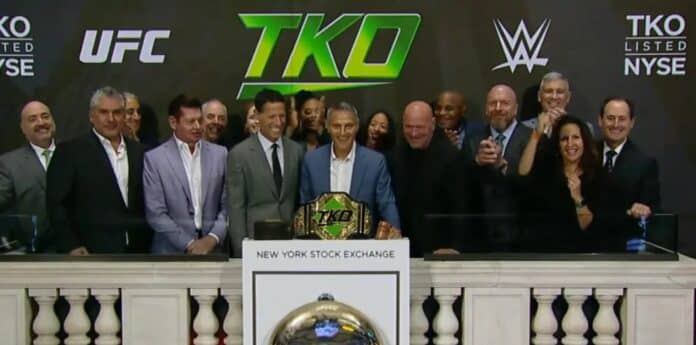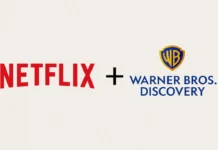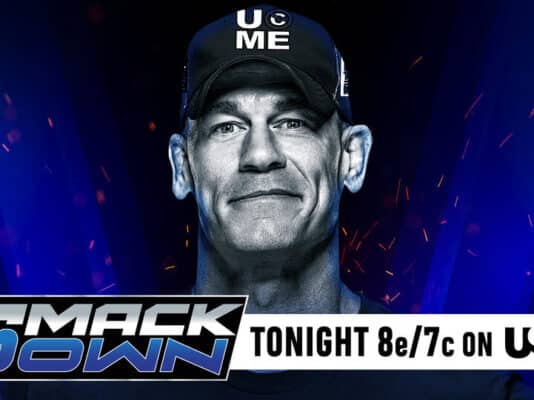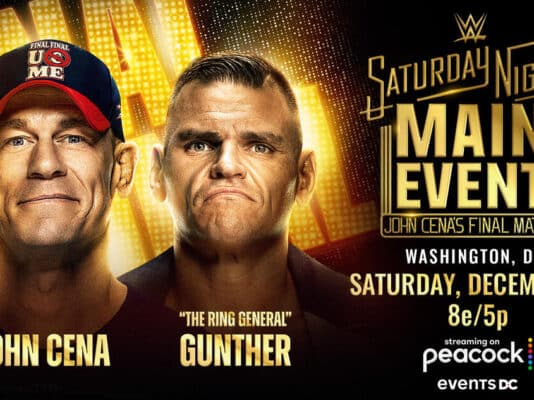
After more than five decades and three generations, World Wrestling Entertainment is no longer under the full control of the McMahon family, as yesterday launched the official start of the TKO Holdings Group, the completion of the blockbuster merger that brought the Ultimate Fighting Championship and WWE together under the Endeavor banner.
As we know, this corporate merger saw Endeavor purchase a 51% controlling stake of the WWE and create a new conglomerate that includes the UFC with the TKO umbrella with an estimated value of $21.9 billion for the newly-created corporation.
The circumstances of the merger, which may or may not have taken place without the Vince McMahon misconduct scandal last year, were well-documented, but given that the TKO group is officially on Wall Street, what does this mean for the biggest sports entertainment organization in the world?
In truth, at least for the foreseeable future, this honestly doesn’t translate to anything different, as WWE will be business as usual since that’s what put them in the position to sell the organization for $9 billion earlier this year. With Nick Khan on the management team to negotiate some massive deals on behalf of the company, WWE was able to leverage the climate of not only the television industry, but also the streaming market to maximize its earning potential before it “cashed out” so to speak with the sale to Endeavor.
With the advancement of modern technology, it’s not so much that viewers are consuming less content, but rather that the countless options sometimes fragment pieces of the audience. For example, there was a time when The Sopranos was the top show on premium television and that along with boxing, fueled subscriptions for HBO through traditional cable providers. In the modern era, a show that has great reviews might not be watched when it would’ve been in a previous era, simply because there’s only a certain amount of time for viewers to consume content and they have to choose that time wisely. It’s not just the TV business either, every podcast and social media influence are also competing for the portion of time that people are willing to dedicate to the consumption of some form of media content. Every media provider, regardless of its a full-scale company or an individual content creator, competes to get viewers for their shows.
In 2019, the TV business needed live content because that was the most DVR proof programming that was available since recording shows allowed for viewers to skip through commercials and thus that can affect ad revenue. Naturally, live content is more expensive to produce, but networks were willing to pay top dollar for it to attempt to maximize ad rates. As much as TV viewership might be down, the NFL and NBA still garner big ratings, obviously because of the mega fan following of each sport, but also because of the live broadcasts. Television networks wanted live programs, and even the sports leagues are seasonal so it made sense for cable stations to consider the WWE brand, mostly based on the fact that there are live shows every week, and that despite a dip in ratings in recent years, there’s still a steady and consistent number for most WWE broadcasts. That consistency allows for advertisers to get a general idea of how many viewers and what demographics will see their products when they buy commercials during Raw or Smackdown.
In retrospect, it’s safe to say that at least Fox overpaid for its five-year rights deal for Smackdown, taking into account that the network actually lost money on the $1.4 billion deal it signed four years ago. The USA network put up $1 billion to keep Raw on the channel for five years. Keep in mind, it wasn’t the popularity of the WWE that landed the contracts, but rather the climate of the television business almost five years ago. In a similar fashion, as a myriad of options over saturated the streaming market, several platforms looked to secure their piece of the streaming pie. As with almost anything, the economics of the situation will more or less determine what services find long term success, but it’s still a unique scenario, as the bulk-pricing model hasn’t been suitable for every form of media.
NBC Universal has Raw on USA and knew that if they bought the streaming rights for the WWE Network, they had a built-in audience that they could sell the Peacock platform to as viewers tuned in to the Monday night show. The Peacock deal was worth $1 billion, again because of the dynamics of the streaming market, not the popularity of WWE. But, from strictly a business perspective, all of that is moot. The WWE was able to secure record-setting profit through its distribution rights contracts.
Obviously, since the most recent TV deals were signed in 2019, the TV business continued to evolve, with less of an emphasis on specifically live content, and more of a focus on different types of programming to attempt to draw from a wider demographic. It goes without say that the WWE won’t get the same amount of cash as they did previously, particularly when Fox lost money on the Smackdown deal.
But, that’s where the TKO merger makes such a massive difference to the entire situation.
At a time when media commodities will have to offer networks consistent and diverse content to land the best TV contract possible, TKO will have all of the bases covered. The UFC is always a target for the 18-34 demographic, while the WWE product skews to have younger and then older fans. Essentially, TKO could theoretically offer networks the chance to secure WWE and UFC programming on their channels. If the pro wrestling side takes a dip, the MMA events can pick up the slack, and if a few key MMA stars aren’t available for a fight, the WWE has its own brand of star power. As simplistic as it sounds, it doesn’t matter what side of the corporation draws for TKO because it’s all revenue for the same organization.
The ability to leverage the sum total of that star power, brand awareness on both sides, and the amount of content gives the TKO group major muscle in the entertainment industry.
Furthermore, with the amount of cash involved, specifically with the TKO stock price at $102 per share when it opened on Wall Street, it’s very doubtful that there will ever be true competition to the WWE again. That’s not a knock on All Elite Wrestling or any other company that might try to be an alternative, but rather to point out that with the WWE/UFC combination, there’s enough money and media muscle to maintain the top spot in the sports entertainment business. WWE brass could easily offer any top AEW performer millions of dollars a year and at some point, a wrestler has to consider the financial security of the contract.
One of the biggest reasons that this gives the WWE exponentially more power within the entertainment industry with this merger is that while you won’t see a crossover with Conor McGregor in the squared circle or Roman Reigns in the octagon, they can run commercials for the next UFC pay-per-view on WWE programming, as well as advertise Raw or Smackdown on the MMA cards. The TKO group can offer networks consistent live programming with a steady audience and the ability to promote shows across different platforms.
The reason that I pointed out that there won’t be a major difference for the on-screen product for the WWE is the same reason there wasn’t a major shift when Endeavor bought the UFC in 2016. The CEO of Endeavor, Ari Emanuel is smart enough to know when there’s already a formula that works. The UFC found what works with how they promote and advertise their fighters. That’s why Dana White is still the outspoken president of the organization. Emanuel knows that Vince McMahon brought the WWE to main stream prominence and isn’t going to change a business strategy that touted record-setting profits for the sports entertainment organization. If Vince McMahon should still be a part of the WWE after the misconduct revelations is a completely different matter. If McMahon is still the best choice to lead the WWE is also a different discussion. However, from strictly a business perspective, there’s no reason for Endeavor to shift anything about the WWE anytime soon since the company yields major profits.
Perhaps, the biggest takeaway from all of this is that besides the fact that this merger gives the WWE extensive power within the media industry, it should be noted that the subpoena and the search warrant that were issued last month from the Securities and Exchange Commission based on the prior Vince McMahon misconduct revelations didn’t prevent the merger. As sleazy as the allegations were, the TKO merger is a win-win scenario for Vince McMahon, as he sold the WWE for billions of dollars and he’s still going to run the company.
Granted, it’s still very historic that the WWE isn’t technically under the control of the McMahon family, but as I said, Ari Emanuel is smart enough not to rock the boat. Theoretically, Vince could be replaced, but it’s a safer bet that he will outlive us all and run Wrestlemania 70 from his usual spot behind the curtain.
What do you think? Share your thoughts, opinions, feedback, and anything else that was raised on Twitter @PWMania and Facebook.com/PWMania.
Until next week
-Jim LaMotta
E mail [email protected] | You can follow me on Instagram, Facebook, & Threads @jimlamotta89












